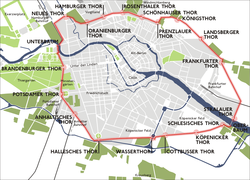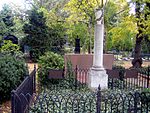Berlin Customs Wall
1737 establishments in the Holy Roman Empire1860 disestablishments in the German Confederation18th-century fortifications18th century in Berlin19th century in Berlin ... and 8 more
Buildings and structures completed in 1737Buildings and structures demolished in 1860City walls in GermanyCustoms buildingsDemolished buildings and structures in BerlinDemolished buildings and structures in GermanyFormer buildings and structures in GermanyFrederick William I of Prussia

The Berlin Customs Wall (German: "Berliner Zoll- und Akzisemauer", literally Berlin customs and excise wall ) was a ring wall around the historic city of Berlin, between 1737 and 1860; the wall itself had no defence function but was used to facilitate the levying of taxes on the import and export of goods (tariffs), which was the primary income of many cities at the time.
Excerpt from the Wikipedia article Berlin Customs Wall (License: CC BY-SA 3.0, Authors, Images).Berlin Customs Wall
Hannoversche Straße, Berlin Mitte
Geographical coordinates (GPS) Address Phone number Website Nearby Places Show on map
Geographical coordinates (GPS)
| Latitude | Longitude |
|---|---|
| N 52.528468 ° | E 13.379933 ° |
Address
IT-Servicepoint
Hannoversche Straße
10115 Berlin, Mitte
Germany
Open on Google Maps










